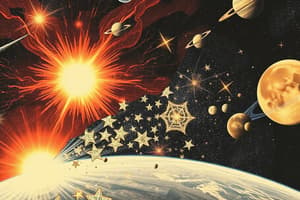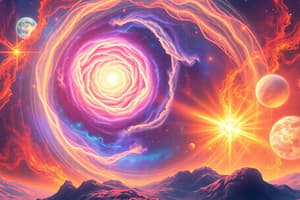Podcast
Questions and Answers
What is the primary reason why the color of a mineral's streak is considered to be a more reliable indicator of its true color than its external color?
What is the primary reason why the color of a mineral's streak is considered to be a more reliable indicator of its true color than its external color?
- Streak color is not affected by the mineral's surface coating or weathering. (correct)
- Streak color is more closely related to the mineral's chemical composition.
- Streak color is more consistent across different specimens of the same mineral.
- Streak color is easier to observe and compare than external color.
Which of the following characteristics describes how a mineral breaks into pieces when subjected to stress?
Which of the following characteristics describes how a mineral breaks into pieces when subjected to stress?
- Hardness
- Luster
- Cleavage and Fracture (correct)
- Streak
Which characteristic determines the extent to which light can pass through a mineral?
Which characteristic determines the extent to which light can pass through a mineral?
- Magnetism
- Tenacity
- Crystalline Structure/Crystal Lattice
- Transparency/Diaphaneity (correct)
What is the significant difference between cleavage and fracture in minerals?
What is the significant difference between cleavage and fracture in minerals?
The Mohs Hardness Scale is used to measure what characteristic of a mineral?
The Mohs Hardness Scale is used to measure what characteristic of a mineral?
Which of the following statements is TRUE about the Steady State Theory?
Which of the following statements is TRUE about the Steady State Theory?
What is the main function of the atmosphere?
What is the main function of the atmosphere?
According to the Big Bang Theory, how did the universe begin?
According to the Big Bang Theory, how did the universe begin?
Which of the following is NOT a physical property of minerals?
Which of the following is NOT a physical property of minerals?
Which Earth subsystem encompasses all environments where life exists?
Which Earth subsystem encompasses all environments where life exists?
Flashcards
Big Bang Theory
Big Bang Theory
The universe began from a single primordial atom, expanding over 13.7-13.8 billion years.
Steady State Theory
Steady State Theory
Universe expands while maintaining constant average density and mass, lacking a beginning or end.
Atmosphere
Atmosphere
Thin layer of gases surrounding Earth, composed mainly of nitrogen & oxygen, protecting from temperatures and UV rays.
Biosphere
Biosphere
Signup and view all the flashcards
Mineral
Mineral
Signup and view all the flashcards
Streak
Streak
Signup and view all the flashcards
Mohs Scale
Mohs Scale
Signup and view all the flashcards
Cleavage
Cleavage
Signup and view all the flashcards
Crystalline Structure
Crystalline Structure
Signup and view all the flashcards
Tenacity
Tenacity
Signup and view all the flashcards
Study Notes
Earth Science - Origin of the Universe
- Big Bang Theory: Proposed by George Lemaître, formulated in 1927; the universe began as a single primordial atom, expanding over 13.7-13.8 billion years.
- Big Bang Theory Characteristics: Started with a singularity; a small, hot, dense state of extremely high density.
- Steady State Theory: Proposed by Sir James Jeans and revised by Fred Hoyle, Herman Bondi, and Thomas Gold. Postulated that despite expansion, the universe's density and mass remain constant, appearing the same throughout; now rejected by most scientists.
- Cosmic Inflation Theory: Supports the Big Bang Theory; describes a period of rapid expansion in the early universe; a rapidly expanding bubble of pure energy.
Earth's Systems
- Atmosphere: A thin layer of gases surrounding Earth; insulates from extreme temperatures, blocks UV rays (made up of 78% nitrogen, 21% oxygen, 0.9% argon).
- Biosphere: The part of Earth that harbors life, varying in conditions from deep roots to high mountains.
- Lithosphere: Earth's solid outer layer, composed of the brittle upper portion of the crust.
- Hydrosphere: All of Earth's water in liquid form, covering about 70% of the surface.
Minerals & Physical Properties
- Mineral Definition: Naturally occurring solid substance with a definite chemical composition; rocks are made of minerals.
- Physical Properties: Include color, streak, hardness, cleavage/fracture, crystal structure, transparency, magnetism, and tenacity.
- Color: Defined by the way minerals absorb light; not a reliable way to identify them.
- Streak: Color of a mineral in powder form; a more reliable indicator.
- Hardness: Measured by resistance to scratching on Mohs Scale (1-softest, 10-hardest).
- Cleavage/Fracture: How a mineral breaks into pieces; cleavage is smooth breaking along crystal structure; fracture is uneven breaking.
- Crystalline Structure: Arrangement of atoms in the mineral crystal; using a hand lens to look for patterns.
Formation of the Solar System
- Nebular Hypothesis: The most widely accepted theory explaining the formation of the solar system; from a rotating gas cloud (nebula) of hot gas; gas cools, nebula shrinks, and rotates faster forming a central hot region = the Sun.
- Planetesimal Theory: A cloud of gas and dust (billions of km in diameter) rotates slowly; cloud shrinks and collapses due to explosion of a nearby star.
Earth Characteristics for Life
- Earth's Position: The third planet from the sun, the only known planet supporting life.
- Supporting Life Features: Water, energy, time, and recycling are Earth's characteristics to support life.
Classification of Rocks
- Igneous Rocks: Formed from the solidification of molten rock.
- Sedimentary Rocks: From the accumulation, compaction, and cementation of sediments.
- Metamorphic Rocks: Formed by the transformation of pre-existing rocks under high pressure and/or temperature.
Geothermal and Hydroelectric
- Geothermal Energy: Power harnessed from Earth's internal heat; three types exist: Dry steam (least common), Flash steam, and binary cycle (uses heat from underground water).
- Hydroelectric Energy: Power from falling water; turbines are spun when water flows which converts kinetic to mechanical energy and electricity.
Soil Conservation
- Soil Conservation: Preventing loss of top layer soil; methods include terrace farming, no-till farming, contour farming, reducing impervious surfaces, planting rain gardens, and restoring wetlands.
- Soil Erosion: Displacement of the upper layer, high acidity, salinity, toxic materials, or overuse.
Waste Management
- Solid Waste: Solids/semi-solids; from houses, industries, etc.
- Hazardous Waste: Industrial, medical, or other potentially unsafe wastes.
- Biomedical Waste: Wastes from hospitals and medical institutions.
- Biodegradable Waste: Organic materials decomposing into carbon dioxide, water, methane, etc.
Studying That Suits You
Use AI to generate personalized quizzes and flashcards to suit your learning preferences.




